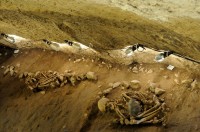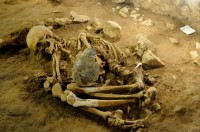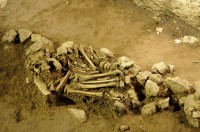 University of Barcelona archaeologists excavating the Can Sadurní cave in Begues, 12 miles southwest of Barcelona, Catalonia, Spain, have found the skeletons of four people who died 6,400 years ago early in the middle Neolithic. Human burials from the same period have been found in the cave before, but they were not so well preserved. These four bodies — one adult male around 50 years old at time of death, one adolescent, a child aged three or four years old and another child of around five or six — weren’t even buried. They were placed in along the north wall of cave and appear to have been covered by a mild landslide shortly after placement. Their bodies had not yet decomposed, so they remained in position when the landslide hit and being covered up helped preserve them.
University of Barcelona archaeologists excavating the Can Sadurní cave in Begues, 12 miles southwest of Barcelona, Catalonia, Spain, have found the skeletons of four people who died 6,400 years ago early in the middle Neolithic. Human burials from the same period have been found in the cave before, but they were not so well preserved. These four bodies — one adult male around 50 years old at time of death, one adolescent, a child aged three or four years old and another child of around five or six — weren’t even buried. They were placed in along the north wall of cave and appear to have been covered by a mild landslide shortly after placement. Their bodies had not yet decomposed, so they remained in position when the landslide hit and being covered up helped preserve them.
All four bodies were placed in a line about three feet apart from each other along the north wall. They were curled in fetal position and positioned on their right sides with their banks turned to the wall. Their knees were bent and pulled up to their chests, their arms bent between the legs and head. This position strongly suggests they were enshrouded or tied up because otherwise their bodies would have relaxed out of this extreme fetal posture. Preliminary examination of the adult skeleton found evidence of severe spinal osteoarthritis and a bone tumor.
 Grave goods were found around the adult male, but not with the younger people. A vessel with two handles was placed on his lap and under his left arm near his elbow archaeologists found a polished bone pendant. Next to him the remains of a calf humerus and two goats were found, and the remains from a strong fire were as well.
Grave goods were found around the adult male, but not with the younger people. A vessel with two handles was placed on his lap and under his left arm near his elbow archaeologists found a polished bone pendant. Next to him the remains of a calf humerus and two goats were found, and the remains from a strong fire were as well.
According to its characteristics, it seems to be derived from only one particular episode which may have only last[ed] some hours, but powerful enough to create an ash layer. Although it is thought that it belongs to a previous burial, other campaigns had already identified in the cave other combustion structures that are contemporary to burial. That suggests that there is a relationship between combustion structures and burial rituals. To be exact, they might correspond to fires lighted to keep vigil over the death the day before their disposal inside the cave.
 Archaeologists are excited to have discovered remains in such good condition because they might shed new light on the Neolithic the ritual burials that were ongoing in this cave for hundreds of years. Bodies were buried in one layer, then in a second layer after the first was covered with sediment and so on for more than two centuries. The top layer of bodies was displaced by a strong landslide, jumbling the remains and scattering them in the cave.
Archaeologists are excited to have discovered remains in such good condition because they might shed new light on the Neolithic the ritual burials that were ongoing in this cave for hundreds of years. Bodies were buried in one layer, then in a second layer after the first was covered with sediment and so on for more than two centuries. The top layer of bodies was displaced by a strong landslide, jumbling the remains and scattering them in the cave.
The particular death rituals of the Neolithic Can Sadurní community have already proven themselves to be of momentous historical import. In 1999, archaeologists found a pottery shard which was found to have traces of oxalate and barley-corn phytoliths. That means beer was held in that pottery vessel when it was whole, and its advance age makes it the oldest beer remains ever discovered in Europe. (It’s also a perfect illustration of how the archaeologist’s focus on collecting every little piece can pay off in a huge way.) It could have been a part of someone’s favorite beer mug, or perhaps the beer was part of the burial rites.
 Last year, an anthropomorphic clay figurine was found just a few inches above the bodies found this year. It’s from approximately the same period, around 6,500 years ago, which makes it the oldest pottery ever discovered in the Iberian peninsula.
Last year, an anthropomorphic clay figurine was found just a few inches above the bodies found this year. It’s from approximately the same period, around 6,500 years ago, which makes it the oldest pottery ever discovered in the Iberian peninsula.
Almost makes you wonder if there’s ever going to be a time to stop digging …
Interesting ! Especially as that is a good age to live 50 years, during the Neolithic age.
Is it possible to extract DNA samples to prove this was a family? I remember a similar “grave” in Iceland, all members of a family placed in a stack under a ledge outcrop, exposed to the cold that mummified the remains, the youngest, an infant, placed on the top. Could it be that when the hunter/provider dies, the rest of the family is buried with him so not to put a strain on the rest of the tribe to provide food for them?